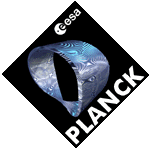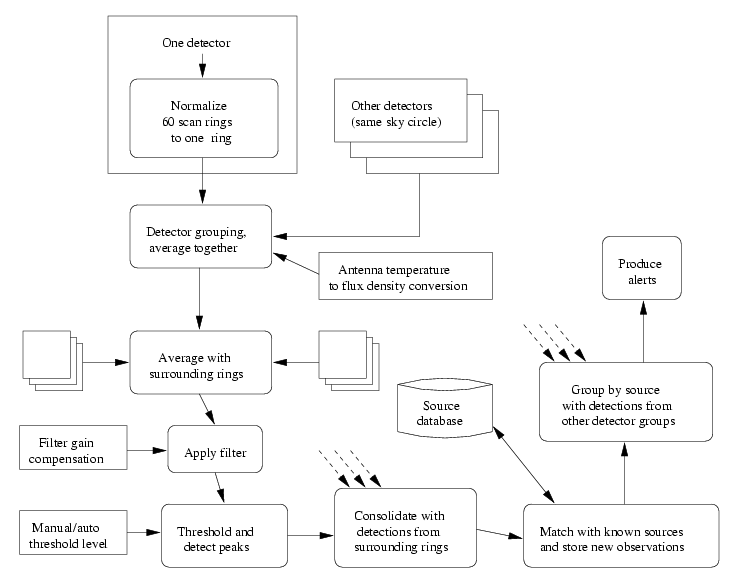The Quick Detection System (QDS) software finds variable point sources in the Planck data stream very shortly after Planck observed them. The goal is to detect interesting sources about a week from the time the data was sent to Earth. QDS uses data from all the LFI detectors.
QDS will make use of the Planck extragalactic point source pre-launch catalog. This database will also be updated by the observations produced by QDS. The program operator checks the results daily and information about interesting ones are sent to collaborating observatories for follow-up observations.
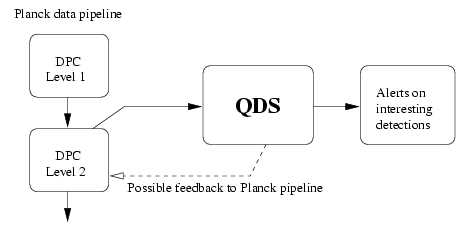 The place of QDS in the Planck data processing pipeline
The place of QDS in the Planck data processing pipeline
Software Operation
QDS is a program implemented with C++ that has all required functionality integrated. It is intended primarily for Planck but it can be used also for other data under certain provisions. The operation of the program is mainly controlled by its configuration file which defines all the needed parameters.
QDS is given the data rings and detector groups to be processed. Every detector group is processed separately one ring at a time, and finally all the results are combined. The following figure illustrates QDS operation on one ring.
The first step in processing a ring is normalizing it. Planck scans one sky circle for 60 revolutions and then changes the direction of its rotating axis. Normalization averages these 60 rings into one noise-reduced ring with well-defined starting point and direction. The signal sample units are also converted from antenna temperature (T [K]) to flux density (S [Jy]) at this time.
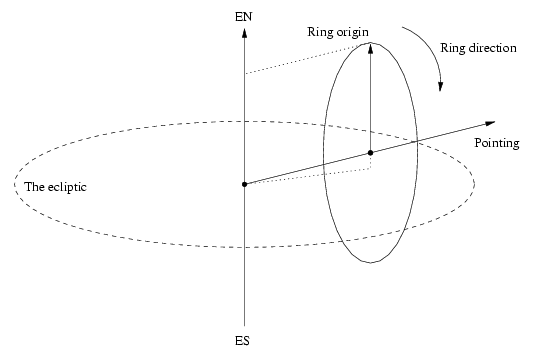 Ring normalization principles.
A normalized ring starts from the ecliptic north and goes around the
pointing vector in the clockwise direction.
Ring normalization principles.
A normalized ring starts from the ecliptic north and goes around the
pointing vector in the clockwise direction.
It is straightforward to average a normalized ring with other normalized rings. Detectors on the same sky circle and which have the same properties form one detector group, the data of which is the average of the rings from its member detectors. In addition to this a further noise reduction attempt can be made by averaging together consecutive rings.
Next phase is the actual point source detection. The rings are filtered with a Mexican Hat Wavelet filter with parameters tuned to emphasize the point sources in the signal. After filtering the noise level σ (RMS noise) is determined and the data is thresholded to detect point sources. The threshold is usually a multiple of the noise level but it can also be given directly in flux density. The following images illustrate the effect of the Mexican Hat filter on the signal.
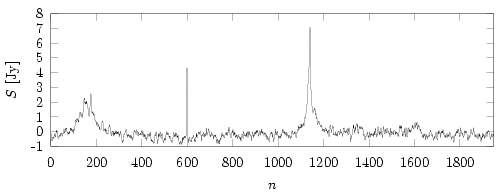
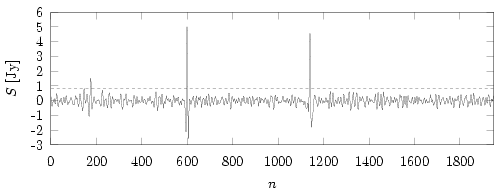 Sample
ring with a 5 Jy point source at n = 600 before
and after filtering. Note especially the background structures at
n ≈ 150 and n ≈ 1150
and the spurious detections caused by them. Detection threshold of
4σ ≈ 0,85 Jy is marked with dashes
in the filtered ring.
Sample
ring with a 5 Jy point source at n = 600 before
and after filtering. Note especially the background structures at
n ≈ 150 and n ≈ 1150
and the spurious detections caused by them. Detection threshold of
4σ ≈ 0,85 Jy is marked with dashes
in the filtered ring.
As a point source is usually visible in several rings, the detection results from all rings must be consolidated to prevent duplicates and to determine the correct values for coordinates and brightness. The detection points sufficiently close to each other are grouped into one detection which has a position and flux determined by its brightest point. Finally the detections are matched against the sources in the QDS source database and saved into the observation history of that source. The detections that satisfy the alert criteria will produce an alert for the operator.
Alert Criteria
The purpose of QDS is not to pick every source above the detection threshold but to determine which of those are interesting and worth follow-up observation. For this purpose the program has four criteria described below. A source produces an alert if it satisfies at least one of the criteria.
-
A source brighter than before
The flux of the source is sufficiently greater than any flux in its observation history on the same frequency. This is expressed by
S > cSmaxwhere S is the current flux, Smax is the greatest flux on the same frequency and c is the threshold coefficient, typically c > 1.
This criterion attempts to detect a flare in those sources that have not flared before. In such a case a flare means that the flux rises above the normal maximum.
-
New flare
The flux is sufficiently greater than the previous observation on the same frequency, the previous observation being sufficiently recent. This is expressed by
S > cSprev ∧ t − tprev < Twhere Sprev is the previous flux, tprev the observation time of the previous flux and T is the time limit, typically in the order of a few months.
This criterion detects sources whose flux is rising (relatively) fast. This may mean that a new flare is beginning, which makes the source interesting.
-
Sources with an inverted spectrum
The source has an inverted spectrum when calculated from the most recent observations. This is expressed by
α1,2 > A ∧ |t1 − t2| < Twhere A is the threshold, typically A > 1, and α1,2 is the spectral index of the source calculated between frequencies ν1 and ν2 with the formula
α = log(S1/S2) / log(ν1/ν2)Note that this uses the definition of spectral index that is proportional to frequency S ∝ να, which is more common in radio astronomy. The other commonly used definition is proportional to wavelength, which is the opposite number of the one above.
To calculate spectral index the observations on different frequencies (at times t1 and t2) should be sufficiently concurrent, otherwise variability in the source may affect it. This is why the criterion has a concurrency time limit T for the observation, typically in the order of a few weeks.
-
New sources
If a detected point source is not found in the QDS database it is interpreted as a previously unknown source which by itself makes it interesting. The majority of the QDS detections will probably be new sources, and the majority of those will be spurious detections caused by noise, the Milky Way galaxy or other background. This is why the program operator must check all new sources extra carefully.
Testing and future work
The program has been tested during implementation with the data produced by the Planck simulator to ensure correct operation. More extensive testing with larger data must yet be done in order to determine optimal values for the program configuration parameters.
Program features possibly added in the future include support for matched filters, optimal Mexican Hat width determination and using several thresholds for one ring based on the galactic coordinates of the sample.
